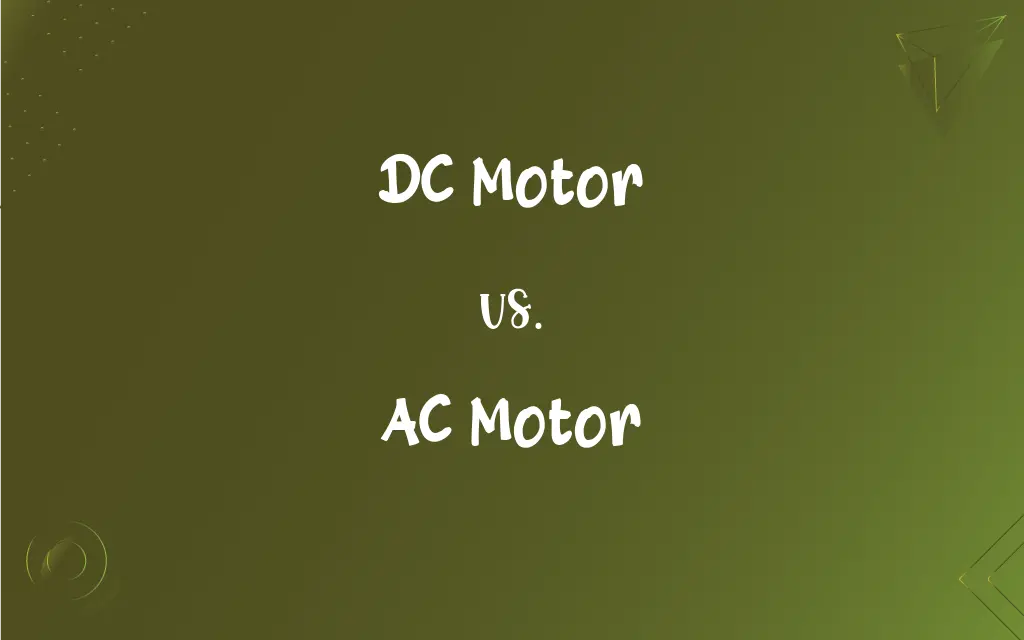DC Motor vs. AC Motor: What's the Difference?
Edited by Janet White || By Harlon Moss || Updated on October 10, 2023
DC motors use direct current and provide continuous rotation, while AC motors run on alternating current and can offer variable speed and torque.

Key Differences
In the broad realm of electrical motors, DC (Direct Current) motors find their unique space by leveraging a constant voltage source. These motors utilize direct current, meaning the electric charge flows in one direction. Consequently, DC motors offer continuous, steady rotation, making them a popular choice in applications where a constant speed and torque are necessary, such as electric vehicles and certain industrial processes.
Contrarily, AC (Alternating Current) motors navigate through the world of industrial and household applications with the prowess of utilizing an alternating current. Here, the electric charge periodically changes direction, providing a distinct characteristic of variable speed and torque. This fluctuation in power delivery allows AC motors to be widely applied in diverse realms, from running household appliances like refrigerators and fans to powering large-scale industrial machinery.
The DC motor has its armature wound with coils, which when supplied with DC power, generates a magnetic field that initiates the motor's movement. The consistency in the voltage direction ensures a reliable, unidirectional rotation, which appeals to situations requiring controlled, consistent motor functionality. For instance, the steady rotation provided by DC motors can be pivotal in applications like conveyor belts in manufacturing processes or elevators, which necessitate a uniform motion.
Alternatively, the AC motor is complex yet flexible in its functionality due to its ability to operate under variable speeds and torques, thanks to the oscillating nature of the alternating current. The pulsating power supply naturally induces a variety of speeds and torques, providing a versatile solution that adapts to the energy demand of different applications. This dynamic behavior of AC motors underpins their broad deployment in diverse scenarios, such as powering variable-speed fans and pumps, where the alteration in speed and power is crucial.
Comparison Chart
Current Type
Uses direct current (constant flow)
Utilizes alternating current (periodic change in direction)
ADVERTISEMENT
Speed and Torque
Typically constant
Can be variable
Complexity
Generally simpler in design
Can be more complex due to variable speed controls
Efficiency and Losses
Can be less efficient and experience more losses
Often more efficient with fewer energy losses
Application Examples
Electric vehicles, simple machines
Household appliances, industrial machines
DC Motor and AC Motor Definitions
DC Motor
A DC motor is an electric motor that operates using direct current, offering steady rotation.
The child's toy car uses a small DC motor to navigate around the track smoothly.
ADVERTISEMENT
AC Motor
AC motors can change speeds and directions due to the nature of the alternating current.
The ceiling fan uses an AC motor to offer multiple speed settings and both clockwise and counter-clockwise rotation.
DC Motor
DC motors provide a consistent torque, maintaining a constant speed throughout the operation.
The consistent speed of the DC motor ensures the conveyor belt moves at a steady pace.
AC Motor
AC motors, particularly synchronous types, maintain synchronization with the supply current's cycle.
The clock uses a synchronous AC motor to ensure that it keeps accurate time by staying in sync with the power grid’s frequency.
DC Motor
DC motors can be designed to operate at various voltage levels to suit different applications.
The portable fan uses a low-voltage DC motor to provide a persistent breeze during hot weather.
AC Motor
AC motors are prevalent in household appliances due to their versatility and varying speed capabilities.
The air conditioner employs an AC motor to regulate fan speed according to the room's cooling requirements.
DC Motor
DC motors traditionally involve a straightforward, less complex construction compared to their AC counterparts.
The simplicity of the DC motor made it an ideal educational tool for the engineering students.
AC Motor
AC motors are commonly utilized in industrial applications due to their ability to handle variable loads and speeds efficiently.
The AC motor efficiently powers the large industrial compressor, adjusting speed based on the system's demand.
DC Motor
DC motors find prevalent use in applications that demand a regular, non-fluctuating operation.
The electric vehicle utilizes a DC motor to facilitate a consistent driving experience.
AC Motor
An AC motor is an electric motor driven by an alternating current.
The AC motor in the washing machine helps it handle varying loads by adjusting its speed during different cycle phases.
FAQs
In which applications are DC motors commonly found?
DC motors are commonly used in electric vehicles, small appliances, and devices requiring steady speed.
Can DC motors operate at different speeds?
Yes, DC motors can operate at different speeds, but this requires varying the input voltage or using a controller.
Where are AC motors typically used?
AC motors are widely used in household appliances, industrial machinery, and HVAC systems due to their versatility.
Is it easy to reverse the rotation direction of AC motors?
Yes, reversing the rotation direction of AC motors is typically straightforward and often involves reversing the phase sequence.
Which motor type is usually better for applications requiring high starting torque?
DC motors are often chosen for applications requiring high starting torque due to their inherent design and control characteristics.
Are DC motors typically more or less complex than AC motors?
DC motors are typically less complex than AC motors due to their straightforward design and function.
What does AC stand for in AC motor?
AC stands for Alternating Current.
How does the complexity of AC motors compare to DC motors?
AC motors can be more complex than DC motors, particularly those designed to control speed and torque accurately.
Is a battery suitable for operating a DC motor?
Yes, batteries, which supply DC power, are suitable for operating DC motors.
How do synchronous and asynchronous AC motors differ?
Synchronous AC motors maintain synchronization with the supply current, while asynchronous AC motors can slip.
What is a fundamental characteristic of AC motors?
AC motors can offer variable speed and torque due to the bidirectional flow of electric charge.
Can AC motors maintain a constant speed under variable loads?
Some AC motors can maintain a constant speed under variable loads, while others can adjust speed based on load.
Why might an engineer select a DC motor over an AC motor for a particular application?
An engineer might select a DC motor for its constant speed and torque, or for applications requiring simpler motor control.
Are AC motors efficient in energy usage?
Yes, AC motors are often highly efficient and may have fewer losses compared to DC motors in some applications.
What determines the speed of a DC motor?
The speed of a DC motor is primarily determined by the input voltage and the number of windings in the armature.
Can AC motors operate under direct current?
While AC motors are designed for alternating current, some can operate under direct current, but with limitations and alterations in performance.
What does DC stand for in DC motor?
DC stands for Direct Current.
What is a fundamental characteristic of DC motors?
DC motors provide constant speed and torque due to the unidirectional flow of electric charge.
What is a common issue with DC motors in industrial settings?
Wear and tear on the brushes in DC motors can be an issue, requiring maintenance.
Can DC motors be used for applications requiring varying speed and torque?
Yes, but it may require additional control systems to manage speed and torque variations effectively.
About Author
Written by
Harlon MossHarlon is a seasoned quality moderator and accomplished content writer for Difference Wiki. An alumnus of the prestigious University of California, he earned his degree in Computer Science. Leveraging his academic background, Harlon brings a meticulous and informed perspective to his work, ensuring content accuracy and excellence.
Edited by
Janet WhiteJanet White has been an esteemed writer and blogger for Difference Wiki. Holding a Master's degree in Science and Medical Journalism from the prestigious Boston University, she has consistently demonstrated her expertise and passion for her field. When she's not immersed in her work, Janet relishes her time exercising, delving into a good book, and cherishing moments with friends and family.































































